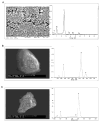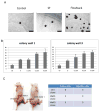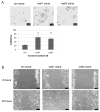Malignant human cell transformation of Marcellus Shale gas drilling flow back water
- PMID: 26210350
- PMCID: PMC4698968
- DOI: 10.1016/j.taap.2015.07.011
Malignant human cell transformation of Marcellus Shale gas drilling flow back water
Erratum in
- Toxicol Appl Pharmacol. 2016 Apr 1;296():85. Zelikoff, Judith [Added]
Abstract
The rapid development of high-volume horizontal hydraulic fracturing for mining natural gas from shale has posed potential impacts on human health and biodiversity. The produced flow back waters after hydraulic stimulation are known to carry high levels of saline and total dissolved solids. To understand the toxicity and potential carcinogenic effects of these wastewaters, flow back waters from five Marcellus hydraulic fracturing oil and gas wells were analyzed. The physicochemical nature of these samples was analyzed by inductively coupled plasma mass spectrometry and scanning electron microscopy/energy dispersive X-ray spectroscopy. A cytotoxicity study using colony formation as the endpoint was carried out to define the LC50 values of test samples using human bronchial epithelial cells (BEAS-2B). The BEAS-2B cell transformation assay was employed to assess the carcinogenic potential of the samples. Barium and strontium were among the most abundant metals in these samples and the same metals were found to be elevated in BEAS-2B cells after long-term treatment. BEAS-2B cells treated for 6weeks with flow back waters produced colony formation in soft agar that was concentration dependent. In addition, flow back water-transformed BEAS-2B cells show better migration capability when compared to control cells. This study provides information needed to assess the potential health impact of post-hydraulic fracturing flow back waters from Marcellus Shale natural gas mining.
Keywords: Barium; Cytotoxicity; Epigenetics; Marcellus Shale; Mutagenesis; Strontium.
Copyright © 2015 Elsevier Inc. All rights reserved.
Conflict of interest statement
Figures






Similar articles
-
Human bronchial epithelial BEAS-2B cells, an appropriate in vitro model to study heavy metals induced carcinogenesis.Toxicol Appl Pharmacol. 2015 Sep 15;287(3):240-5. doi: 10.1016/j.taap.2015.06.008. Epub 2015 Jun 17. Toxicol Appl Pharmacol. 2015. PMID: 26091798 Free PMC article.
-
Tungsten-induced carcinogenesis in human bronchial epithelial cells.Toxicol Appl Pharmacol. 2015 Oct 1;288(1):33-9. doi: 10.1016/j.taap.2015.07.003. Epub 2015 Jul 9. Toxicol Appl Pharmacol. 2015. PMID: 26164860 Free PMC article.
-
Luteolin inhibits Cr(VI)-induced malignant cell transformation of human lung epithelial cells by targeting ROS mediated multiple cell signaling pathways.Toxicol Appl Pharmacol. 2014 Dec 1;281(2):230-41. doi: 10.1016/j.taap.2014.10.008. Epub 2014 Oct 23. Toxicol Appl Pharmacol. 2014. PMID: 25448439 Free PMC article.
-
Potential water resource impacts of hydraulic fracturing from unconventional oil production in the Bakken shale.Water Res. 2017 Jan 1;108:1-24. doi: 10.1016/j.watres.2016.11.006. Epub 2016 Nov 4. Water Res. 2017. PMID: 27865434 Review.
-
Current perspectives on unconventional shale gas extraction in the Appalachian Basin.J Environ Sci Health A Tox Hazard Subst Environ Eng. 2015;50(5):434-46. doi: 10.1080/10934529.2015.992653. J Environ Sci Health A Tox Hazard Subst Environ Eng. 2015. PMID: 25734820 Review.
Cited by
-
Unconventional oil and gas development and risk of childhood leukemia: Assessing the evidence.Sci Total Environ. 2017 Jan 15;576:138-147. doi: 10.1016/j.scitotenv.2016.10.072. Epub 2016 Oct 23. Sci Total Environ. 2017. PMID: 27783932 Free PMC article.
-
Pathways for Potential Exposure to Onshore Oil and Gas Wastewater: What We Need to Know to Protect Human Health.Geohealth. 2025 Apr 3;9(4):e2024GH001263. doi: 10.1029/2024GH001263. eCollection 2025 Apr. Geohealth. 2025. PMID: 40182626 Free PMC article. Review.
References
-
- Alomary A, Al-Momani IF, Obeidat SM, Massadeh AM. Levels of lead, cadmium, copper, iron, and zinc in deciduous teeth of children living in Irbid, Jordan by ICP-OES: some factors affecting their concentrations. Environmental monitoring and assessment. 2013;185:3283–3295. - PubMed
-
- Bamberger M, Oswald RE. Impacts of gas drilling on human and animal health. New solutions : a journal of environmental and occupational health policy : NS. 2012;22:51–77. - PubMed
Publication types
MeSH terms
Substances
Grants and funding
LinkOut - more resources
Full Text Sources
Other Literature Sources
Medical

